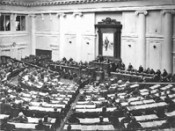
The Russian Empire Third State Duma began its work
November 1 (14), 1907 the Third State Duma began its work. It was the only one of the four in Russian Empire which had functioned for the entire period of 5 years fixed by the election law.
June 3 (16), 1907 along with the decree dissolving the Duma of the second convocation was issued a new Regulation on the elections to the Duma (a new electoral law), under which the new Duma was convened. Dissolution of the Second State Duma and the publication of a new electoral law went into history as the June Third Revolution.
The new electoral law expanded the rights of landlords and big bourgeoisie, who received two-thirds of the total number of electors; to the workers and peasants were left about a quarter of the electors. Representation of the people of some national borderlands was drastically reduced: the peoples of Central Asia, Yakutia, and some other national areas were completely excluded from the election. Worker and peasant electors were denied the right to elect deputies from among its members. This right has been transferred to the provincial election assembly dominated, in most cases, by landowners and the bourgeoisie. City Curia was divided into two parts: the first was represented by the big owners, the second – by the petty bourgeoisie and the urban intelligentsia.
Elections to the Third State Duma took place in autumn of 1907. The total number of deputies was reduced from 518 to 442 people. The Third State Duma in its composition was far of the right-wing trend in comparison to the previous two: the majority was the Octobrists - 154 deputies, the right-wing and moderate right-wing got 121 mandates, the Cadets - 54. The chairman of the Duma was elected Octobrist N. A. Khomyakov, who, in March of 1910, was replaced by a large merchant and industrialist Octobrist A. I. Guchkov; in 1911 the post of chairman of the Duma was occupied by the leader of the Octobrists M. V. Rodzianko. There were about 30 committees in the Duma, eight of which were permanent: budgetary, financial, for the implementation of state policies on revenues and expenditures, editorial, for requests, library, personnel, and administrative. The committees’ members were elected at a general meeting of the Duma after the prior approval of candidates in the fractions. All factions had their representatives in the majority of committees.
During its work, the Duma had held over 600 meetings, considered about 2.500 bills, of which the vast majority had been submitted by the government. Among the major bills approved by the Duma, were the laws on peasant private land ownership, the insurance of workers, the introduction of local government in the western regions of the empire.
The Third State Duma had held five parliamentary sessions and was dissolved by an imperial decree in June of 1912.
Lit.: Аврех А. Я. Столыпин и третья Дума. М., 1968; Выборы в I–IV Государственные думы Российской империи (Воспоминания современников. Материалы и документы). М., 2008; Государственная Дума: III созыв — 3-я сессия. Справочник 1910 г. СПб., 1910. Вып. 2; Из «Положений о выборах в Государственную Думу от 3 июня 1907 года» (Именной высочайший указ правительствующему сенату от 3 июня 1907 г.) [Электронный ресурс] // Руниверс. Б. д. URL: http://www.runivers.ru/doc/d2.php?SECTION_ID=6776&CENTER_ELEMENT_ID=147282&PORTAL_ID=7138; Кирьянов И. К., Лукьянов М. Н. Парламент самодержавной России: Государственная Дума и её депутаты, 1906-1917. Пермь, 1995.
Based on the Presidential Library’s materials:
State Duma in the history of Russian statehood : [digital collection];
3-й созыв Государственной Думы: портреты, биографии, автографы. СПб, 1910;
Приложения к стенографическим отчётам Государственной думы. Т. 1: (№№ 1-143). 1910;

